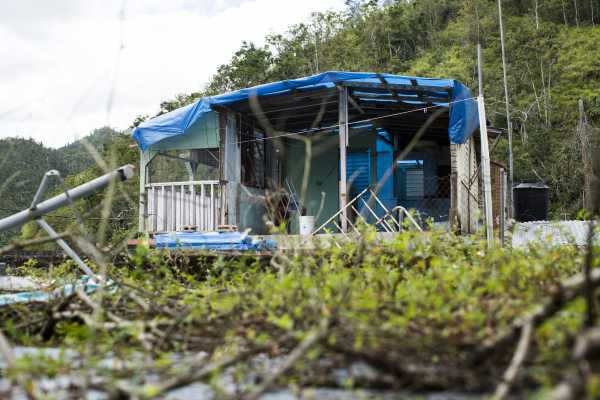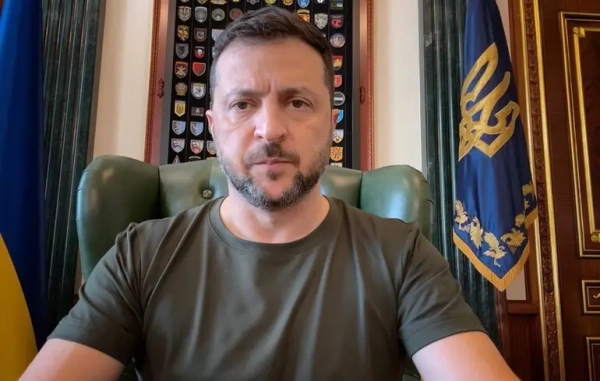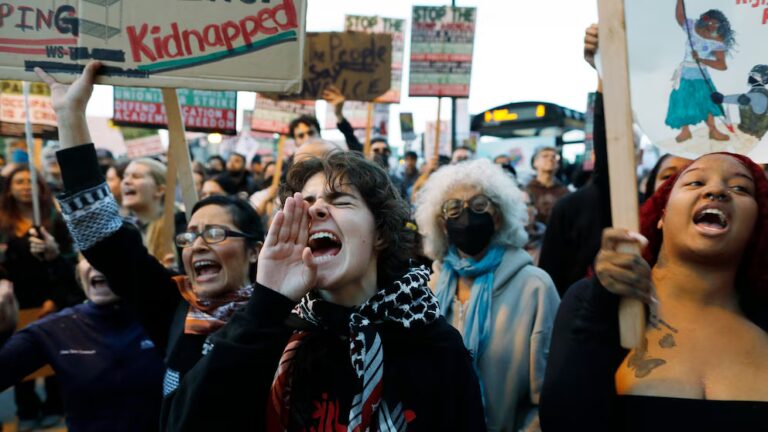
It’s been six months since Hurricane Maria’s 155 mph winds plowed through Puerto Rico, leaving the island severely crippled and desperate for help.
The storm — which knocked out all power and most cellphone service — was the worst disaster ever to hit the Caribbean island, home to 3.4 million American citizens.
The island is still a long way from recovery. Federal workers there are still in emergency mode: The Federal Emergency Management Agency (FEMA) is still distributing food and water supplies; the Army Corps of Engineers is still picking up hurricane debris and installing blue roofs on damaged homes.
Helping Puerto Rico recover is a gargantuan task — FEMA has called it the “largest federal response to a disaster” in American history. But this response has also been unusually painful to watch, with shady contracting deals, a drinking water crisis, and the army of federal responders stretched too thin to effectively get help to everyone quickly. FEMA is also under intense scrutiny for hiring inexperienced contractors, including one company that failed to deliver thousands of meals.
Money is another problem. The government of Puerto Rico was bankrupt before the hurricane hit and needs a lot more cash to rebuild. In February, Congress approved $15.8 billion in FEMA aid specifically for Puerto Rico and the US Virgin Islands — far less than the estimated $94 billion needed just for Puerto Rico. (Within six weeks of Hurricane Katrina, by comparison, Congress had authorized $60 billion in aid to disaster zones.)
Restoring electricity has been another headache, though progress has been slow. About 7 percent of the island’s electricity users still don’t have power, and it’s unclear when power will be fully restored. The lack of basic services has fueled a mass exodus from the island, which demographers expect will only worsen. More than 250,000 people have left Puerto Rico for the US mainland — possibly for good.
Here are five important things to know about Puerto Rico six months after Maria.
1) Rural areas still don’t have electricity
The government of Puerto Rico says 93 percent of island’s electricity customers now have power, mostly in urban areas such as San Juan. This is a huge improvement from three months ago, when only 65 percent were connected to the grid. However, these official figures have been disputed by four mayors, according to Puerto Rico’s El Nuevo Día newspaper. They accused the utility company in January of inflating the numbers of customers in their cities who had power.
Regardless of the statistics, the lack of power is still affecting many Puerto Ricans.
The teachers association of Puerto Rico said dozens of schools still haven’t been connected to the power grid, according to an Oxfam report released this week.
“These schools often run on generators, which results in teachers holding classes for only four hours in the morning due to fuel costs, instead of the usual seven hours per school day,” the report explains.
There are many reasons it’s been so hard to restore power. For one, the power grid was a mess before the storm hit. The public utility company, PREPA, had been putting off repairs for years as the island sank into a deep economic recession. The utility company is also bankrupt and understaffed, as thousands of electrical workers have retired or moved to the US mainland in the past decade to find better jobs.
While the storm didn’t destroy the entire power grid, it did knock down 80 percent of the island’s utility poles and all transmission lines. And because Puerto Rico’s government is broke, it didn’t have the money to start repairing the grid right away. Instead, the head of PREPA at the time, Ricardo Ramos, signed two questionable contracts with little-known private American energy companies that required little payment up front. Ramos planned to pay the rest of the contracts with reconstruction grants from FEMA.
The main energy contract never got that far. It was a massive $300 million deal with Whitefish Energy, a tiny Montana company that had two employees at the time.
A congressional investigation later found that Whitefish Energy ended up charging Puerto Rico more than double the regular wages for utility crew line workers and higher-than-normal daily meal rates, and included clauses making it hard for PREPA to enforce a timeline.
The public backlash led Ramos to cancel the contract and resign from his job, and PREPA had to find a new contractor.
Now the US Army Corps of Engineers is overseeing grid repair contracts with more experienced utility crews from the mainland. But the logistics are still a mess. Building and shipping thousands of utility poles and power lines to the island, then setting them up on mountainous terrain, has become a headache for utility crews. And some of the equipment is so old that manufacturers had to make parts just to work for Puerto Rico’s system. That has slowed everything down.
The Army Corps’ last estimate was to have 100 percent of customers hooked up to the grid by the end of May.
2) Few Puerto Ricans can return home
Thousands of Puerto Ricans still don’t have a place to live.
Buildings in Puerto Rico were not made to withstand 155 mph winds. The governor says Maria completely destroyed 87,094 homes, with another 385,703 sustaining major damage.
More than 3,500 Puerto Ricans are still living in hotels on the island and across the United States with temporary housing vouchers provided by FEMA. The program has been extended twice by the agency because few homes have been fixed.
That’s another problem. FEMA has approved less than 40 percent of the 1 million applications for money to help disaster victims fix their homes, according to NPR. The reason is that many, many Puerto Ricans do not hold the deeds to their homes. In rural areas in particular, the process of buying a home can be quite casual, based on verbal agreements or handshakes. Others built homes on public land, essentially living as squatters. But FEMA requires homeowners to show proof that they own their homes to qualify for assistance.
That’s one major reason thousands of Puerto Ricans might never return home.
3) The island is dealing with a suicide crisis
Puerto Rico is dealing with a serious mental health emergency.
The number of people on the island who have reportedly tried to kill themselves since Hurricane Maria hit the island has more than tripled. From November 2017 through January 2018, a crisis hotline run by Puerto Rico’s Department of Health received 3,050 calls from people who said they had attempted suicide. That’s an astounding 246 percent increase compared to the same time last year.
This data was released in a report in January by the health department’s Commission for Suicide Prevention, with additional reporting from El Nuevo Día, Puerto Rico’s largest newspaper.
Even more people called the hotline to report suicidal thoughts (as opposed to those who attempted suicide). About 9,645 people who called the hotline in the past three months said they’d thought about killing themselves — an 83 percent jump from the same time last year.
These numbers offer a snapshot of the mental health crisis unfolding in Puerto Rico.
The rate of Puerto Ricans who chose to end their lives is also on the rise. The suicide rate in 2017 was the highest it has been since 2013, and men and older Puerto Ricans were much more likely to kill themselves.
It’s hard to tell how much of the spike is directly related to the aftermath of Hurricane Maria. But the likely connection is difficult to ignore.
Julio Santana Mariño, a psychology professor at Universidad Carlos Albizu in Puerto Rico, said that Hurricane Maria made a lot of problems in Puerto Rico far, far worse, particularly high unemployment and homelessness. These are common risks factors for suicides, he told El Nuevo Día.
The devastation from the hurricane likely pushed many people over the edge, he added. “It’s normal for there to be family conflicts, but when you add the stress of more than five months without power, without food, living patterns change … it makes it harder for people to manage daily life,” Santana Mariño told the newspaper.
4) Hundreds of thousands of Puerto Ricans have fled the island
The blackout, food shortages, and unreliable running water plaguing Puerto Rico in Maria’s aftermath have triggered an exodus from the island.
It’s impossible to know exactly how many Puerto Ricans have left, but more than 269,000 people have arrived in Florida on flights from Puerto Rico since the hurricane, according to the Florida Division of Emergency Management.
Some people are staying with relatives; some have decided to relocate to the US mainland; others are staying at hotels paid for by FEMA.
Before the hurricane, the Orlando area had seen a surge of migration from Puerto Ricans leaving the island for job opportunities in the United States as a result of the recession.
Demographers expect Maria to trigger an even larger migration in the long term. The Center for Puerto Rican Studies at the City University of New York estimates that Puerto Rico will lose up to 470,335 residents by the end of 2019 — about 14 percent of the population.
They believe that many of them will move to Florida — up to 82,000 people a year.
The migration has already affected Florida. More than 10,000 Puerto Rican children have enrolled in Florida’s public schools in the past three months.
5) The death count recount
Six months after the hurricane hit, the government has no idea how many people died as a result of the storm. The governor ordered a recount three months ago, which should be completed in April.
The official hurricane death toll has been a source of controversy since President Trump visited the island on October 3 and congratulated Gov. Ricardo Rosselló for the low number of deaths. At that time, the number was six. The official death count — now at 64 — has since been disputed by the press (including Vox), by academics, and by members of Congress.
In November, Vox published an analysis by social science researchers who used mortality data from the Puerto Rico Vital Statistics System to compare the historical death averages for September and October and found that the number of people who died from the storm is closer to 1,085. A New York Times analysis of similar data found that the death toll could be at least 1,052.
In December, two members of Congress, Reps. Nydia Velázquez (D-NY) and Bennie Thompson (D-MS), requested a federal investigation by the Government Accountability Office. In a letter to the head of the GAO, they said they worried that the death toll had been “artificially suppressed.”
Five days after the letter was sent, Rosselló ordered a recount of all hurricane deaths.
Staff from Puerto Rico’s Public Safety Department and Demographic Registry will investigate each death recorded in the hurricane’s aftermath, regardless of the official cause of death listed on the death certificate, Rosselló said. He did not give details about how the investigation will work or how long it will take.
But many are skeptical of Rosselló’s ability to provide accurate estimates at this point. Velázquez said she will continue to press for an independent federal review.
Sourse: vox.com






